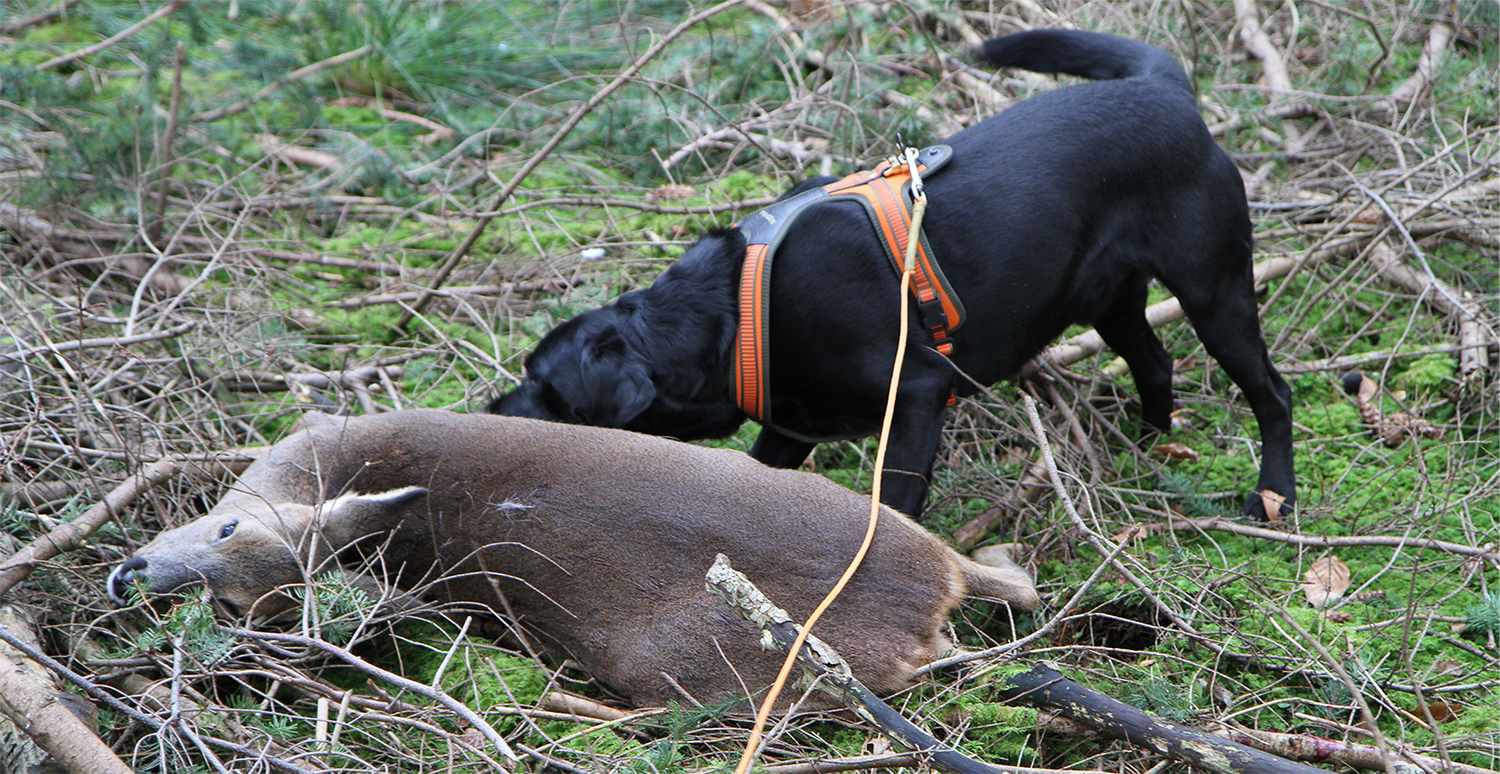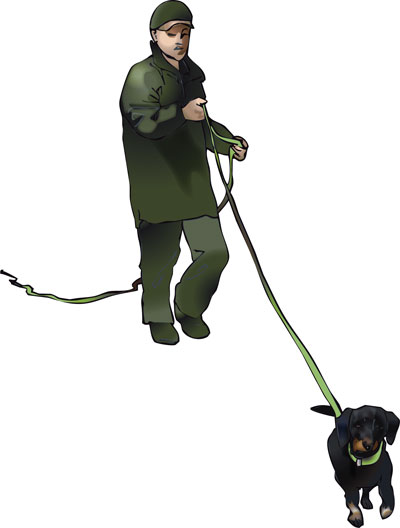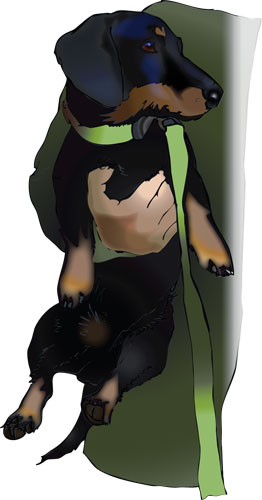Aim

The aim of this guide is to describe the use of dogs as an aid to deer management, in particular the use of dogs for finding dead deer and tracking injured deer [1]
This guide is linked to the “Reaction and Follow up” guide[2], which should be considered essential companion reading.[3]
Why use a dog?
Deer dogs are most useful for two main tasks:
- Finding dead deer. Lethally shot deer may sometimes be hard to find depending on terrain, cover, or light conditions, a dog can easily locate recently dead deer by ground or air scent (“Hot tracking”).
- Tracking injured or wounded deer. After a car accident, or a shot that was not immediately lethal, a deer may travel some distance. Even after many hours, a dog will be able to track the deer and if necessary, it can be dispatched. (“Cold tracking”).
- It is not essential to have a dog with you when stalking but all deer stalkers should have access to a suitable dog or be able to contact a dog and handler team, particularly for woodland stalking
Suitable breeds of dog:
Many breeds of dog of all sizes can be trained to work with deer.
It is recommended that a dog intended for working with deer is initially trained solely for that purpose.
Basic training
Discipline is essential in any working dog, they should be
- Calm, confident, and reliable when recalled, especially in the presence of deer, game and livestock;
- Reliable when at heel
- Steady to the sound of rifle fire;
- Capable of staying in one place for extended periods).
Most dogs with this level of training should be perfectly capable of accompanying a stalker, of indicating the presence of live deer, and of hot tracking well shot deer.
For a dog to become efficient at tracking injured deer, including cold tracking, additional training is recommended.
Training Dogs for cold tracking
A dog trained specifically for cold tracking is capable of accurately following a scent trail, even from a lightly injured animal. The trail may be 24 hours or more old and stretch over long distances, possibly miles/kilometres. Such a dog will also easily follow a “hot” track if the handler decides that is appropriate (see also part 2 of this guide)
- Cold tracking training should be well embedded before a dog is allowed to follow hot tracks or track live deer.
A well trained dog works slowly enough to “indicate” any relevant signs that they find, and at a speed that the handler is able to spot and check these signs. At a year or so old most dogs should easily be able to follow a 400 m trail, with turns, 3 hours old, and using only 25cl or so of blood or no blood at all. More experienced dogs should be able to follow a much older or more complicated trail. Cold track training should be regular, even experienced dogs benefit from reinforcement training, especially those that are also used on hot tracks. - Most tracking is done using the leash but it may be necessary at the end of a track to release the dog so, when reliable at cold tracking, they should also be trained to either bay or hold deer if necessary.
- Handlers also need experience. They should be able to recognise any information that the dog’s behaviour provides and know how to maximise the chances of a find. Important skills are being able to analyse the “strike” (or “shot site”) and acting accordingly (See the Follow up of Shot Deer guide), as well as knowing how best to help the dog get re-started on a trail if the trail is lost. Handlers should also be competent at humane dispatch[4]
A number of organisations offer advice and training for tracking dogs and handlers as well as a free, confidential tracking service using an experienced dog/handler team. Amongst these, in alphabetical order are:
Bavarian Mountain Hound Society (BMHS)
UK Deer Track and Recovery (UKDTR)
UK Scent Hound Association (UKSHA)
Decision to bring in a dog for tracking
- All shots taken at deer should be followed up by the stalker (see the Reaction and Follow up guide*).
- Following the correct follow up procedure will lead the stalker to the “strike” or “shot site”, i.e. the place where the deer was standing when the bullet was fired. This should then be clearly marked.
If a dog is already present it should be kept a little distance away whilst evidence is being examined.
If, judging from the signs, there is a high degree of confidence that the deer is well shot, it can be tracked by following the blood trail by eye or, if a dog is present, it can be put through its “hot” tracking routine. If at any time subsequently the animal is obviously lost, pause and review options as per the “Deciding on how to track the deer” section below. - Otherwise, using a dog to track a shot deer should always be considered when:
- from the shooting position, it is obvious that the animal is wounded and has gone out of sight and that a dog is likely to be required. In this case, estimate where the shot site is for finding later, but leave it undisturbed until you return.
- at the shot site there is no sign of a bullet strike, or of the deer. A surprising number of “missed” deer are subsequently found, often perfectly well shot, but occasionally wounded. A trained dog will be able to confirm a hit or a true miss.
- the signs at the shot site indicate that the animal is wounded rather than already dead.
- a search has been made without a dog, but the animal is still lost. Note that the longer or more intensive an unsuccessful search is, the harder it may be to track the animal subsequently because repeated trampling can spread the scent away from the true trail.
- Once the decision to bring in a tracking dog has been made, it is best to leave the area undisturbed until the dog is available
Deciding on how to track the deer

- If a shot deer is lost and/or known to be wounded, there is a natural tendency to want to begin tracking straight away. Instead, time should be taken to decide on the course of action which is most likely to ensure that the animal is found.
This may depend on:
- The need for help. It might be appropriate (for instance around very dense cover) to take time to strategically and safely place other shooters to intercept and humanely dispatch the animal should it still be mobile and is disturbed by the tracker.
- The species of deer. If undisturbed, territorial species can be more likely to cover less distance or return to their home area sooner. They will often lie down and become unable to move sooner than the large species, but their scent seems to dissipate faster.
- Time of day[4]. Tracking wounded deer at night is difficult, can result in a lost animal or dog, makes it difficult to see to take a safe follow up shot, and can be dangerous, both to the dog and handler. It is usually more sensible to return the next morning. See also, Legislation.
- Type of wound and time since shot. It is generally not a good idea to track a lost deer immediately after the shot, except when it is known to have been well shot. This is because after the shot, a wounded animal will often move a short distance then lay down. If it is disturbed too soon after the shot it may well be able to get up (often unseen), run further away and be less inclined to stop again. This makes tracking more difficult and may considerably prolong the time taken to find the deer. Experience indicates that the chance of finding a wounded animal increases if the time elapsed after the shot is delayed up to 4 hours for a gut shot and 12 hours after a leg shot. The decision to wait, or proceed sooner, may however depend on the precise circumstances. See also, Legislation.
Tracking with a dog

- The dog is usually worked on a long leash because the handler:
- can allow the dog to work freely but is ultimately able to restrain it if required.
- will have the best chance of visually confirming that the dog is on the trail.
- will gain more information from the dog via its behaviour, and thus be able to monitor the situation as it develops.
- Whenever possible, introduce the dog to the trail at the (previously marked) strike/shot site. After allowing the dog to get it’s bearings it should lock on to the trail, with the handler following carefully on foot.
- As tracking proceeds, confirmed signs should be marked, in case the trail is lost further on and it is necessary to return.
- The handler must keep a look out for the wounded animal and, if it is spotted, stop the dog and then decide what to do.
- Dogs are not usually worked “free” i.e. off the leash, because of the additional risk that the dog will get out of control, chase the target or another animal unbidden, and/or become lost or injured. In some situations, such as on very open ground or in dense cover, a decision may be taken to let the dog work free. Such dogs should be specifically trained for the purpose, the area must be safe and the dog should ideally work the trail at a slow pace, enabling the handler to keep up, to confirm signs and to stay in contact and control. A GPS collar with mapping app will help find the dog/deer and can be useful for track monitoring and general navigation.
Locating and dispatching
- If the deer is located alive, the preferred method of dispatch is to safely shoot it, taking care that bystanders and the dog are in a safe position. If the deer runs before it can be shot, or a safe shot will not be possible, a decision has to be made as to whether to resume tracking or to allow the dog to bay or secure the deer. Because of the risk of losing both dog and deer should a chase ensue, or of injury to the dog, releasing the dog is not recommended unless:
- There is a very high degree of confidence that the deer is in such a condition that the dog will be able to secure it quickly, either at bay or by holding it, so that it can be humanely dispatched.
- The dog has been trained to hold or bring deer to bay and, if it goes out of sight, report to the handler in some way that it has found either the live animal or a carcass and be able to direct the handler to it. A GPS unit may assist with this.
Once the deer is secured it should be dispatched as soon as possible [5]
Hygiene
- Dogs should not be allowed to maul found deer or carcasses unnecessarily. Dogs should not be allowed into the deer larder, or the storage area of any vehicle used for transporting carcasses. Depending on the nature of the wound, the time elapsed, and the level of carcass contamination, previously wounded animals may not be suitable for putting into the human food chain (See the Meat Hygiene suite of guides).
Dog welfare
- The dog should be kept in good physical health.Ensure the dog is safely positioned before firing a shot.
Do not allow inexperienced dogs to tackle live deer off the leash until they are steady and have been trained for the purpose.
Carry a canine First Aid kit and check dogs for injury after working.
Do not allow a dog to run free where it is likely to get lost or run into or cause a danger e.g. near a road or livestock.
GPS and radio collars for finding dogs are available as a safeguard. If the dog is wearing any collar while working free, it should be of a design that will detach if the dog becomes entangled.
Legislation
- Dogs are not obliged by law to wear identification collars while being used for “sporting purposes”, which includes tracking deer.
All dogs must be Micro-chipped and registered.
Deer are protected from hunting with dogs under two Acts. There are exceptions relevant to tracking wounded deer built into these Acts to allow for: - The retrieval or location of a wild mammal by a dog that the handler reasonably believes is seriously injured or orphaned, provided that person acts to ensure that the mammal, once located, is captured, treated or killed as humanely as possible in order to relieve its suffering: Protection of Wild Mammals (Scotland) Act 2002, Section 5 (1) (c).
- The humane destruction of an injured, diseased or orphaned deer by means that are normally prohibited: Deer (Scotland) Act 1996, Part 3, Section 25 (a) (b).
Section 25 of the Deer (Scotland) Act 1996 may provide a reasonable defence in law if there is a need to follow a wounded deer onto adjacent property and dispatch it in order to prevent suffering. However, firearms legislation requires that anyone taking a firearm onto any land must have the permission of that landowner, preferably in writing. In such circumstances the landowner should be notified and permission granted before entry. A prior arrangement is a good way to avoid misunderstanding or prosecution. If it is necessary to temporarily abandon a search on adjacent property, then recommence later, it is essential to clarify with the landowner that all persons involved are again permitted to do so.
For authorised night shooting in woodland, the presence of a suitable dog is a requirement.[6]
[2] See DCSG Night Shooting: Code of Practice
[3] See BPG Humane Dispatch
[4] See BPG Reaction to Shot and Follow-Up
[5] See BPG Humane Dispatch
[6] See DCSG Night Shooting: Code of Practice
